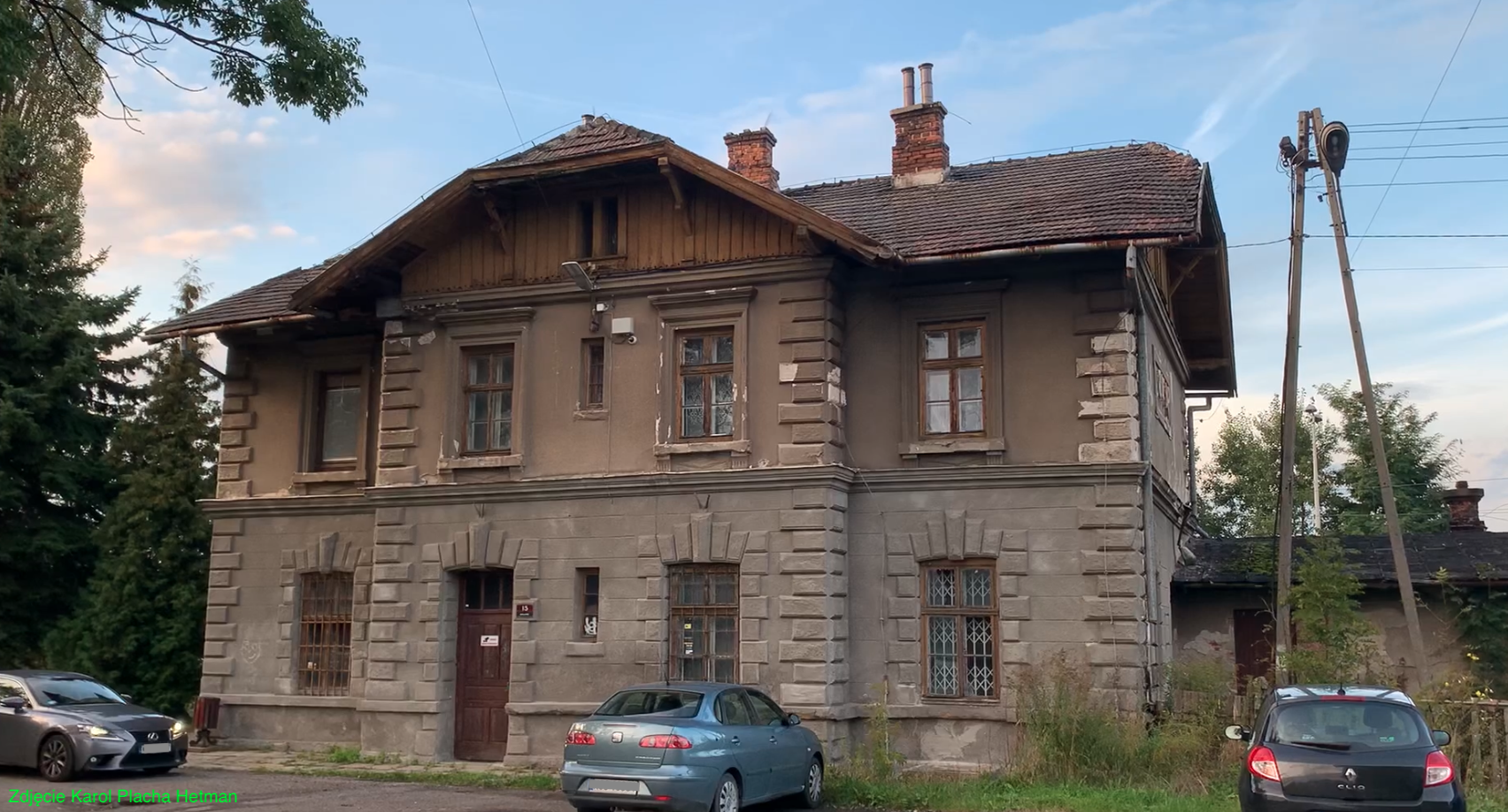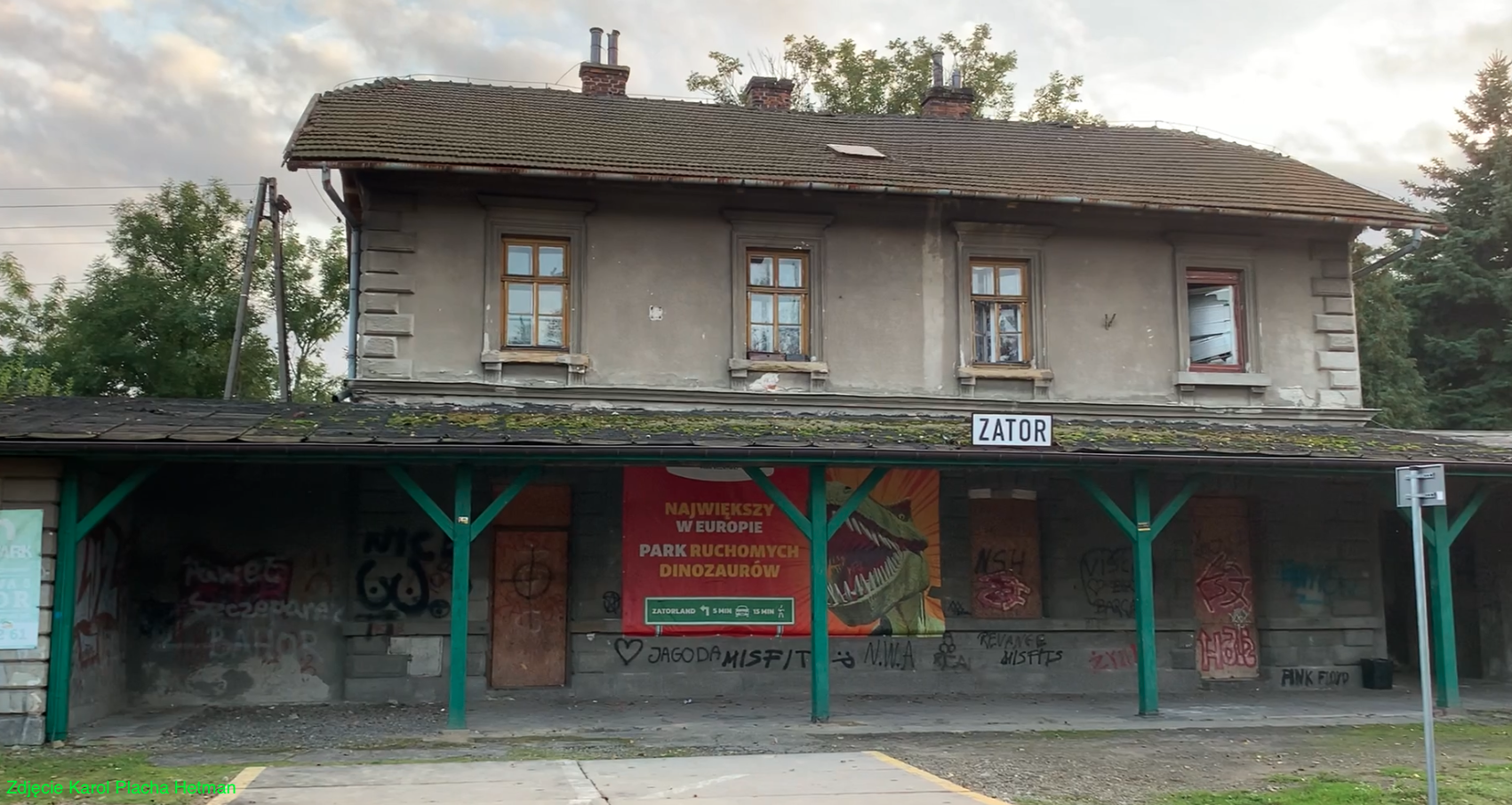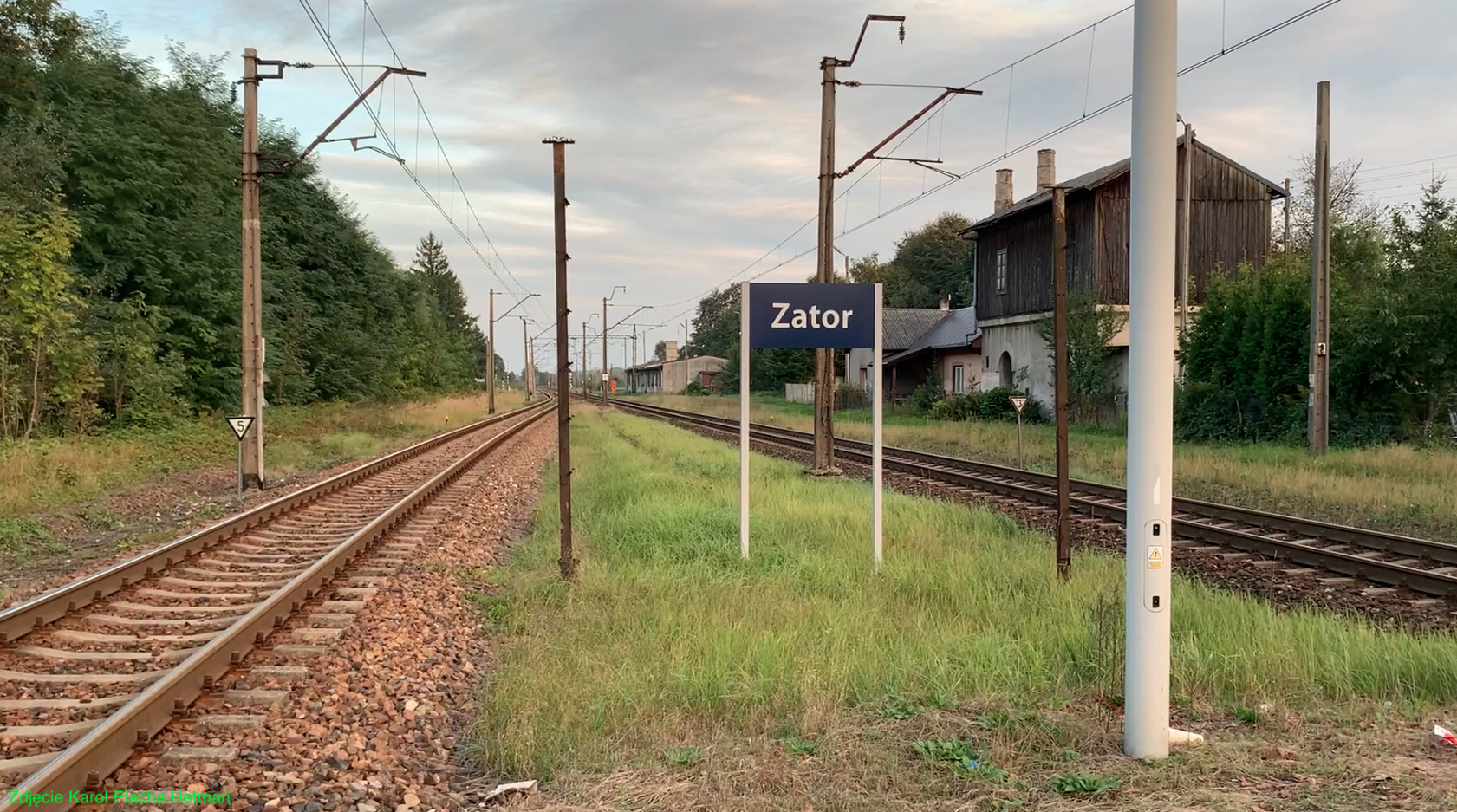Zator 2023-10-26
Zator railway station near Oświęcim.
Geographic coordinates: 50.002N 19.429E. Elevation 226 m.



Photo description: View towards Spytkowice, Skawina, Kraków. On the right side there is a water tower and a medical clinic building.

Photo description: View towards Oświęcim.
City of Zator.
The Duchy of Oświęcim-Zator was a historical territory in Poland, in the Krakow Land. It covered the area where the cities of Oświęcim and Zator were located, located in today's Lesser Poland Voivodeship. The Duchy of Oświęcim-Zator was part of the Kingdom of Poland and existed as an independent principality from the 14th to the 18th century, although it was repeatedly incorporated into various state structures. In the Middle Ages, it belonged to the Piast dynasty, and in later centuries it was influenced by various dynasties and states. The most important period in the history of the Duchy of Oświęcim-Zator was its incorporation into the Crown of the Kingdom of Poland in 1564, when the princes of Oświęcim and Zator obtained the title of royal starostas general. However, the Duchy retained some autonomy and independence until the partitions of Poland at the end of the 18th century.
After the partitions of Poland, the area of the Duchy of Oświęcim-Zator was divided between Austria and Prussia, and later incorporated into the Duchy of Warsaw and the Kingdom of Poland. After the Congress of Vienna in 1815, most of the territory of the Duchy was incorporated into the Kingdom of Poland, a state completely dependent on the Muscovites.
Currently, the area that once constituted the Duchy of Oświęcim-Zator is part of Poland and no longer exists as a separate territory. The cities of Oświęcim and Zator are part of the Lesser Poland Voivodeship.
The settlement of Zator was founded in the 12th century. The first mention of the settlement appeared in 1228. City rights were granted in 1292, but the city was deprived of these rights in 1896, during the partitions. The city regained city rights in the Second Polish Republic in 1934.
Currently (2023) Zator is a city in Poland, located in the Lesser Poland Voivodeship, in Oświęcim County. It is located on the Skawa River, approximately 40 kilometers west of Kraków. From the city of Zator, Kraków is 42 km away, Oświęcim is 19 km away, and Warsaw is 310 km away. There is a nice town hall building in the city. The city is known for fish farming, especially king carp. There are many natural and artificial water reservoirs in the area.
The Skawa River is a small river in Poland that flows in the Lesser Poland Voivodeship. The river flows in the area of the Western Beskids and the Zachodniobeskid Foothills through the Żywiecki Beskids, then through the Makowski Beskids and the Mały Beskids, and the river flows through several towns, including Maków Podhalański, Jordanów, Zator, and finally flows into the Vistula River. The Skawa River has a relatively short course, but is an important watercourse in the region. Its surroundings are picturesque, and the Skawa valley is a naturally valuable area. The river is also a popular spot for anglers who come here to fish. There are also numerous hiking and bicycle trails in the vicinity of Skawa, which attracts outdoor recreation enthusiasts.
The city of Zator has an area of 11.52 square kilometers. The city's population is 3,664 inhabitants (2019). Historic buildings in the city of Zator include: The parish church of St. Adalbert and St. George, from 1393. Castle in Zator, originally with defensive features. Tenement houses at the market square and the town hall. Railway station. A park from the 19th century. Zator has about 50 historical buildings.
Zator railway station.
In 1884, the Oświęcim - Zator - Podgórze (Kraków Prokocim) railway line was opened. It was the second railway line from Silesia towards Lviv, bypassing Kraków. The first was the line: Mysłowice - Trzebinia - Kraków, which was built on the initiative of the Prussians. This second line was further proof of how Austria-Hungary continually humiliated the Royal Free City of Krakow, which was eventually deprived of its autonomy and incorporated into Galicia. The Zator station is 42.080 km of the Krakow - Oświęcim route.
The Zator - Spytkowice station was a junction station for some time. In addition to the Kraków - Stawina - Zator - Oświęcim line No. 94, there was a Trzebinia - Zator - Wadowice line, line No. 103.
Due to the popularity of the Energylandia amusement park, an additional railway stop was built in Zator.
At the Zator station there is one island platform, with two edges. There is also a historic station building and a historic water tower. The same water tower was at the Skawina station. Next to the water tower there is a building where there was a medical clinic.
The station is a typical 19th century station building that was built in Galicia. The building is small, two-story, covered with a hipped roof. From the station square, the central part is a projection topped with a swallow. There is one entrance door to the building. on the ground floor there was a ticket and luggage counter, a shop/buffet, a waiting room, service rooms and a narrow staircase leading upstairs. There were apartments on the first floor and it remains so until now (2023). Initially, the building had no water or electricity installations. The building was heated by tiled stoves fired with coal and wood. Toilets were in separate annexes. The station's attic was unusable and the roof was covered with tiles. The station was equipped with a lightning protection system. There are seven windows in the front wall and small windows in the staircase and attic. On the station side, the building is equipped with a wooden shelter covered with sheet metal. The lower floor has two doors, separate for passengers and railway workers, and two windows. There are four windows on the second floor. The building is decorated with simple ornaments.
At the Zator station there is one island platform, with two edges. The platform is of the low type, with an asphalt surface. There are four new bus shelters on the platform. Access to the platform is at track level. There is also a historic water tower. The same water tower was at the Skawina station. Next to the water tower there is a building where there was a medical clinic.
On October 1, 2022, KMŁ trains were launched on the Kraków Główny - Skawina - Zator - Przeciszów route. Currently, passenger trains in Zator are operated by Koleje Małopolskie (KMŁ). In October 2023, Zator stations were served by 10 pairs of trains on the Kraków - Skawina - Zator - Przeciszów route. In 2022, during the holiday season, the station served up to 300 passengers per day.
Railway line No. 94 Kraków Płaszów – Oświęcim.
Railway line No. 94 Kraków Płaszów - Oświęcim starts at the Kraków Płaszów station. Then it runs through: Kraków Podgórze Peron 2 (1,430 km), Kraków Bonarka (3,120 km), Kraków Łagiewniki (4,380 km), Kraków Sanktuarium (5,340 km), Kraków Swoszowice (7,090 km), Kraków Opatkowice (9,660 km), Kraków Sidzina (11,590 km), Skawina Jagielnia (14,200 km), Skawina (15,470 km), Skawina Zachodnia (17,680 km), Podbory Skawińskie (19,420 km), Zelczyna (21,500 km), Wielkie Drogi (23,940 km), Jaśkowice (26,630 km) , Brzeźnica (29,940 km), Półwieś (33,940 km), Ryczów (36,860 km), Spytkowice (42,080 km), Zator (45,600 km), Zator Amusement Park (47,300 km), Przeciszów (50,110 km), Włosienica (53,300 km) , Dwory (57,370 km), Oświęcim (64,502 km).
Railway line No. 94 Kraków Płaszów - Oświęcim is a line running from east to west. The line is 64.502 km long, is a double-track line and is electrified with 3 kV DC. The line was launched in 1884. Electrification was carried out in two stages; on October 30, 1970, on the Kraków Płaszów - Spytkowice section and on September 9, 1971, on the Spytkowice - Oświęcim section. The route is of national importance, mainly for freight traffic between Silesia and Krakow. Since 2000, passenger traffic on the line has been decreasing, especially on the Skawina - Oświęcim section. The section Kraków Płaszów - Skawina was important because it continued with line No. 97 towards Zakopane. The last passenger train covering the entire line No. 94 in 2014 was the international InterRegio train from Kraków to Ostrava in the Czech Republic: Kraków - Skawina - Oświęcim - Czechowice Dziedzice - Zebrzydowice - Ostrawa. In 2015, train services on the Kraków - Skawina - Oświęcim route were restored. However, after a year, due to the poor condition of the tracks and the long travel time, it was suspended again. At the end of 2022, after renovations, passenger traffic was restored.
In 2017, a long-distance InterCity train ran on the route: Warsaw - Kraków - Skawina - Oświęcim - Dziedzice - Vienna. There was also a train from Przemyśl - Kraków - Trzebinia - Oświęcim - Prague. Connections have been suspended due to the renovation of line No. 93 from Trzebinia to Czechowice Dziedzice and the renovation of the Dziedzice junction. The renovations are scheduled to be completed by the end of 2023.
In 2022, the tender for renovation works on the Podbory Skawińskie - Oświęcim section was resolved. The tender for the preparation of design documentation and construction works on the Podbory Skawińskie - Oświęcim section as part of the modernization of the railway line No. 94 Kraków - Oświęcim was announced in April 2022. 10 companies took part in the tender, and ultimately the winner was the Railway Infrastructure Repair and Maintenance Company in Krakow. The price was one of the criteria for selecting offers, and PNiUIK offered PLN 113,697,900 gross for the task. This is below the cost estimate, which amounted to PLN 117,443,576.63 gross. As part of the investment in the "design and build" system, works will be carried out on the Podbory - Brzeźnica and Dwory - Oświęcim routes. In addition, it is planned to demolish the old bridge and build in its place a new railway bridge over the Spytkowicki stream (Brzezinka) and Zamkowa Street, along the railway line No. 94 Kraków Płaszów - Oświęcim in Spytkowice. The implementation time was 16 months. In spring 2024, passenger trains will return along the entire route.
Railway line No. 103 Trzebinia – Skawce.
The Trzebinia - Skawce railway line was launched on August 15, 1899. It was a line of local importance, on which no freight or passenger trains currently run. Except for the short section Okleśna - Spytkowice, for freight traffic. The line was single-track, electrified, running from north to south. The line was called "Lokalbahn Skawce - Siersza Wodna", and after Poland regained independence it was called "Skawce local railway - Siersza Wodna". The line was immediately built as 1,435 mm standard gauge.
Electrification of line No. 103: On May 30, 1982, Trzebinia - Bolęcin. On October 25, 1991, Bolęcin - Spytkowice. On December 22, 1989, Spytkowice - Wadowice. The Wadowice - Skawce section was not electrified after the Świnna Poręba dam was built and part of the route was flooded.
The railway line No. 103 Trzebinia - Skawce started at the Trzebinia station. Then there were stations and stops; Piła Bożecka (3,110 km), Bolęcin (4,750 km), Oblaszki (8,570 km), Regulice Górne (9,560 km), Regulice (12,070 km), Alwernia (14,260 km), Okleśna (18,020 km), Miasto (19,400 km), Spytkowice (23,520 km), Trzebieńczyce (26,230 km), Grodzisko (28,410 km), Woźniki (31,390 km), Radocza (33,710 km), Wadowice (37,400 km), Czartak (42,730 km), Mucharz (46,450 km), Zagórze ( 49,980 km), Skawce (54,360 km).
After World War II, mainly local passenger trains from Sucha - Wadowice - Szczakowa / Siersza Wodna ran on line No. 103. Mainly employees of mines, power plants and other industrial plants rode the trains.
Traffic was suspended in stages: On August 10, 1988, Wadowice - Mucharz. On April 15, 1992, Mucharz - Skawce. On October 7, 2002, freight and passenger traffic Trzebinia - Wadowice. On March 1, 2009, Spytkowice - Wadowice.
Written by Karol Placha Hetman
